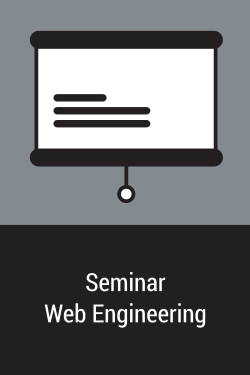
Web Engineering Seminar (WS 2024/2025)
Welcome to the homepage of the Web Engineering Seminar
This website contains all important information about the seminar, including links to available topics as well as information about the seminar process in general.
The interdisciplinary research area Web Engineering develops approaches for the methodological construction of Web-based applications and distributed systems as well as their continuous development (evolution). For instance, Web Engineering deals with the development of interoperable Web Services, the implementation of web portals using service-oriented architectures (SOA), fully accessible user interfaces or even exotic web-based applications that are voice controlled via the telephone or that are represented on TV and Radio.
The following steps are necessary to complete the seminar:
- Preparation of a presentation about the topic assigned to you.
- An additional written report of your topic.
- Each report is reviewed by two or three other particpants.
Seminar chairs

Maheshika Hansamalee Walpola M.Sc.


Contact
If you have any questions concerning this seminar or the exam as a participant, please contact us via OPAL.
We also offer a Feedback system, where you can provide anonymous feedback for a partiular session to the presenter on what you liked or where we can improve.
Participants
The seminar is offered for students of the following programmes (for pre-requisites, please refer to your study regulations):
- Master Web Engineering (500410 Seminar Web Engineering)
Registration
You may only participate after registration in the Seminar Course in OPAL
The registration opens on 14.10.2024 and ends on 21.10.2024 at 23:59. As the available slots are usually rather quickly booked, we recommend to complete your registration early after registration opens.
Topics and Advisors
Topics and Advisors will be published before the selcetion of topics.
Questions:
- What is the current state of Web Engineering research? To answer this question, systematically analyze all publications of the 2 venues listed under literature as detailed below. Your primary information used should be the title, authors/affiliations, keywords, and abstract.
- For each publication, capture title, authors/affiliations, keywords, and abstract, venue, year, (for conference papers) name of track/workshop, (for journal articles) volume number, (for journal articles) issue number, (for journal articles) name of issue, page numbers in proceedings/issue, length of the publication, current number of citations of the publication, URL of online resource.
- Based on your raw data collection, analyze the following aspects: 1. What are the main topics of research interest and in which areas of the Web Engineering field, along with the number of publications belonging to them? 2. What authors are publishing in these venues, from which affiliations, from which countries, along with the number of publications for each of these? 3. Which are the most cited articles (relative to their age), which topics/areas receive the most citations, which authors/affiliations/countries receive the most citations? 4. Considering the time dimension, are there any visible trends for aspects 1-3 over the 5 years considered?
- Visualize your data and insights and provide the raw data in re-usable form (CSV).
Literature:
- Venue 1: ICWE Proceedings of last 5 complete years (2019-2023)
- Venue 2: JWE Journals Issues of last 5 complete years (2019-2023)
- For citation counts use: Google Scholar
- Tool for analysis and inspiration for your data visualization: https://www.connectedpapers.com/
Questions:
- Which technologies, frameworks, patterns, paradigms, best-pratices and guidelines are currently used by web applications?
- To answer the question, conduct a survey gathering publicly available information from web repositories and identification through semi-automatic analysis.
- Start by identifying relevant UI Testing patterns, paradigms, best-pratices and guidelines in published literature (and potentially gray literature).
- Then, write supporting scripts and crawl public repositories (GitHub, Gitlab, Bitbucket, etc.) to identify applications using UI Tests.
- Per each application, identify the aspects from question one and keep track of the source of information (e.g. the URL of the corresponding source code), the type of application (domain), the application technology (e.g. programming language, web frameworks).
- Summarize your findings across all surveyed applications using statistical methods and visualizations and show if there are differences in the UI Testing aspects across the different application technologies.
Literature:
- Orient your methodology on the following paper: http://www.pautasso.org/biblio-pdf/apiace-icwe2023-versioning.pdf
- You own research is required to identify relevant UI Testing technologies, frameworks, patterns, paradigms, best-pratices and guidelines
Questions:
- How does a Systemization of Knowledge work? Prepare a guideline for computer science students explaining the main aspects.
- How does it compare to a Systematic Literature Review? How does it compare to a Systematic Mapping Study? When to apply which one?
- What are risks and limitations of the method?
- Which SoK artifacts should be provided to allow for reproducibility and replicability?
- What tools exist to support SoKs? Demonstrate a suitable tool.
Literature:
- https://www.jsys.org/type_SoK/
- https://oaklandsok.github.io/
- https://dl.acm.org/doi/pdf/10.1145/3613904.3642315
- Kitchenham, B. (2004). Procedures for Undertaking Systematic Reviews. https://www.inf.ufsc.br/~aldo.vw/kitchenham.pdf
- Kitchenham, B., Pearl Brereton, O., Budgen, D., Turner, M., Bailey, J., & Linkman, S. (2009). Systematic literature reviews in software engineering - A systematic literature review. Information and Software Technology, 51(1), 7–15.
- Brereton, P., Kitchenham, B. a., Budgen, D., Turner, M., & Khalil, M. (2007). Lessons from applying the systematic literature review process within the software engineering domain. Journal of Systems and Software, 80(4), 571–583.
- Petersen, K., Vakkalanka, S., & Kuzniarz, L. (2015). Guidelines for conducting systematic mapping studies in software engineering: An update. Information and Software Technology, 64, 1–18.
- Díaz, O., Medina, H., & Anfurrutia, F. I. (2019). Coding-Data Portability in Systematic Literature Reviews. Proceedings of the Evaluation and Assessment on Software Engineering - EASE ’19, 178–187.
- Khadka, R., Saeidi, A. M., Idu, A., Hage, J., & Jansen, S. (2013). Legacy to SOA Evolution: A Systematic Literature Review. In A. D. Ionita, M. Litoiu, & G. Lewis (Eds.), Migrating Legacy Applications: Challenges in Service Oriented Architecture and Cloud Computing Environments (pp. 40–71). IGI Global.
- Jamshidi, P., Ahmad, A., & Pahl, C. (2013). Cloud Migration Research: A Systematic Review. IEEE Transactions on Cloud Computing, 1(2), 142–157.
- Rai, R., Sahoo, G., & Mehfuz, S. (2015). Exploring the factors influencing the cloud computing adoption: a systematic study on cloud migration. SpringerPlus, 4(1), 197.
- A. Hinderks, F. José, D. Mayo, J. Thomaschewski and M. J. Escalona, "An SLR-Tool: Search Process in Practice : A tool to conduct and manage Systematic Literature Review (SLR)," 2020 IEEE/ACM 42nd International Conference on Software Engineering: Companion Proceedings (ICSE-Companion), 2020, pp. 81-84.
- PRISMA 2020 http://www.prisma-statement.org/
Questions:
- Which access control models exist?
- Which prerequisites must be met for their application to knowledge graphs?
- Compare the access control models you found in both their granularity of control and performance.
Literature:
- Own research
Questions:
- What is characteristic of REST APIs? What distinguishes a RESTful API from other APIs?
- Which design patterns and best practices exist for the design and development of REST APIs?
- Which REST APIs exist in the Semantic Web domain?
Literature:
- Fielding, Roy Thomas. Architectural Styles and the Design of Network-based Software Architectures. Doctoral dissertation, University of California, Irvine, 2000.
- Own research
Questions:
- Which information are needed to generate an REST API automatically?
- Which tools exist for the generation of REST APIs?
- Demo: setup a simple scenario to compare example REST API generators.
Literature:
- Own research
Questions:
- What are chatbots and why are they used in customer service industry? What are they used for? What are chatbot interaction patterns? Present your findings.
- Create a corpus of Customer Service Chatbots that you analyze on certain criteria. The corpus should include at least 70 different chatbots from different industries. Build a scientifically valid strategy on how to systematically search for these customer service chatbots and describe your methodology.
- Have a look at the chatbot interfaces and categorize them. The following questions can be used as an idea for criteria and added on (use the available literature to formulate specific criteria): Does the chatbot have an avatar and/or name? Which gender can be assigned to either? Are there any access restrictions? Can the user access the chatbot on the landing page or do they have to further navigate? Where is the chatbot situated on the homepage? Does the chatbot use "I" to refer to itself? How is the user greeted?
- Additionally catalog which interaction patterns are used by the chatbot and add this information to your analysis. Note down if you find any possible new patterns.
- Create screencasts of this conversation and screenshots of meaningful interactions. For this and your chatbot analysis you will get access to a gitlab repository in which you can save your results. Present your analysis results with examples.
Literature:
- Own research
- Følstad, A., Larsen, A.G., Bjerkreim-Hanssen, N. (2023). The Human Likeness of Government Chatbots – An Empirical Study from Norwegian Municipalities. In: Lindgren, I., et al. Electronic Government. EGOV 2023. Lecture Notes in Computer Science, vol 14130. Springer, Cham. https://doi.org/10.1007/978-3-031-41138-0_8
- Chaves, A. P., & Gerosa, M. A. (2020). How Should My Chatbot Interact? A Survey on Social Characteristics in Human–Chatbot Interaction Design. International Journal of Human–Computer Interaction, 37(8), 729–758. https://doi.org/10.1080/10447318.2020.1841438
- Traubinger, V., Gaedke, M. (2024). Interaction Design Patterns of Web Chatbots. In: Stefanidis, K., Systä, K., Matera, M., Heil, S., Kondylakis, H., Quintarelli, E. (eds) Web Engineering. ICWE 2024. Lecture Notes in Computer Science, vol 14629. Springer, Cham. https://doi.org/10.1007/978-3-031-62362-2_22
Questions:
- What are Interaction Design Patterns? Provide some examples from everyday interactions on graphical user interfaces. How can these patterns be transferred to other interfaces (especially chatbots)?
- Search for 40 chatbots in the domain of e-commerce and analyse them on their use of chatbot interaction patterns. For this you will get access to a gitlab repository in which you can save your results. Create a guideline for an interaction with the chatbot and communicate based on these guidelines with all collected chatbots. The guidelines should be usable to find most, if not all chatbot interaction patterns. Make screencasts of this conversation and screenshots of meaningful interactions.
- Create a collection of different variations of chatbot interaction patterns. This should show how they can be graphically and conversationally implemented. Present a selection of these patterns and their variations with practical examples.
Literature:
- Own research
- Traubinger, V., Gaedke, M. (2024). Interaction Design Patterns of Web Chatbots. In: Stefanidis, K., Systä, K., Matera, M., Heil, S., Kondylakis, H., Quintarelli, E. (eds) Web Engineering. ICWE 2024. Lecture Notes in Computer Science, vol 14629. Springer, Cham. https://doi.org/10.1007/978-3-031-62362-2_22
- Tidwell, J., Brewer, C., Valencia, A.: Designing Interfaces: Patterns for Effective Interaction Design. O’Reilly, Beijing [China]; North Sebastopol, CA, third edition edn. (2020)
Questions:
- What are chatbots, which technical properties do they have and how can they be developed? What is published about them from the scientific community? Conduct a literature research and present a survey of at least 15 different platforms that can be found by the literature and via the internet.
- Analyse the collected platforms on meaningful characteristics based on the literature. The analysis should include several factors like payment plans, required technological knowledge, hardware requirements, implementation options and specifically a focus on the possibility to make changes to the user interface. Add other characteristics based on your literature research. Present your analysis results.
- As a demonstration choose 2-3 platforms and provide a practical comparison of a chatbot implementation based on a meaningful use case you can choose on your own.
Literature:
- Own research
- Dagkoulis, I., & Moussiades, L. (2022, November). A Comparative Evaluation of Chatbot Development Platforms. In Proceedings of the 26th Pan-Hellenic Conference on Informatics (pp. 322-328).
- S. Pérez-Soler, S. Juárez-Puerta, E. Guerra and J. de Lara, "Choosing a Chatbot Development Tool," in IEEE Software, vol. 38, no. 4, pp. 94-103, July-Aug. 2021, doi: 10.1109/MS.2020.3030198. keywords: {Chatbot;Software tools;Computer applications;Companies;Social networking (online);Testing;Software Engineering;Chatbots;Natural Language Processing},
- Adamopoulou, Eleni, and Lefteris Moussiades. "An overview of chatbot technology." IFIP international conference on artificial intelligence applications and innovations. Springer, Cham, 2020.
- Traubinger, V., Gaedke, M. (2024). Interaction Design Patterns of Web Chatbots. In: Stefanidis, K., Systä, K., Matera, M., Heil, S., Kondylakis, H., Quintarelli, E. (eds) Web Engineering. ICWE 2024. Lecture Notes in Computer Science, vol 14629. Springer, Cham. https://doi.org/10.1007/978-3-031-62362-2_22
Questions:
- What are data infrastructures, and how do they organize data in distributed systems? Present at least two to three types and categorize them.
- How are knowledge graphs applied in web engineering or distributed systems? Provide real-world examples.
- What are the strengths and weaknesses of using knowledge graphs in distributed systems?
- How do different implementations of knowledge graphs compare in terms of performance and scalability?
Literature:
- Own research
- Obraczka, D., et al. "Construction of Knowledge Graphs: Current State and Challenges." Information, 2024, doi: 10.3390/info15080509.
- Heiko Paulheim, et al. "A Knowledge Graph Perspective on Knowledge Engineering." Machine Learning and Knowledge Extraction, 2022, doi: 10.1007/s42979-022-01429-x.
- Bradley P. Allen, et al. "Evaluating Class Membership Relations in Knowledge Graphs Using Large Language Models." arXiv, 2024.
Questions:
- Conduct a systematic literature review on how knowledge graphs are used for data integration in web engineering.
- How do knowledge graphs compare to traditional data management methods regarding integration, performance, and scalability?
- What are the latest trends in knowledge graph research, including AI integration?
- What challenges do knowledge graphs face in real-time data integration, such as handling data heterogeneity and scalability?
- How can knowledge graphs be optimized for better performance in web engineering applications?
Literature:
- Own research
- Färber, M. "Applications of Knowledge Graphs in Industry." IEEE Access, 2019, doi: 10.1109/ACCESS.2019.2933496.
- Paul Groth, et al. "Knowledge Graphs and their Role in the Knowledge Engineering of the 21st Century." Dagstuhl Reports, 2022.
- Ji, S.; Pan, S.; Cambria, E.; Marttinen, P.; Philip, S.Y. "A survey on knowledge graphs: Representation, acquisition, and applications." IEEE Transactions on Neural Networks and Learning Systems, 2021, doi: 10.1109/TNNLS.2021.3070843.
Questions:
- What are knowledge graphs? Describe what they are and why they are important
- How do we assess the quality of knowledge graphs? Discuss various metrics used for evaluation.
- What are the methods for validating knowledge graphs? Explain different approaches to ensure their accuracy and reliability.
- What challenges exist in knowledge graph evaluation and validation? Identify issues faced in maintaining high-quality knowledge graphs.
Literature:
- Own research
- Huaman, J. and Kärle, E., “Knowledge Graph Validation,” 2020 IEEE International Conference on Data Mining Workshops, DOI: 10.1109/ICDMW51313.2020.00114. Available: Semantic Scholar
- Schuitema, S. and Vreeken, J., “Knowledge Graph Completeness: A Systematic Literature Review,” HAL Archives, 2021. Available: HAL
- Schlichtkrull, M., et al., “Modeling the Future of Knowledge Graphs: Towards a Framework for Knowledge Graph Evaluation,” Wageningen University, 2022. Available: Wageningen
- Zhang, C., et al., “A Survey on Knowledge Graphs: Representation, Acquisition, and Applications,” arXiv, 2020. Available: arXiv
Questions:
- Intro: Prompt engineering is an emerging discipline for developing and optimizing prompts to efficiently use language models (LLMs) to enable or assist applications and research topics in a wide variety of domains, including web engineering.
- Shortly introduce the basics of prompting.
- Explain and demonstrate common prompting techniques.
- Explain and (if already possible) demonstrate more complex prompting techniques currently used or discussed.
- Review currently available libraries and tools useful for prompt engineers.
Literature:
- Own research
Questions:
- Introdcution: Prompt engineering involves crafting text in a manner that can be comprehended and processed by a generative AI model. A prompt serves as the natural language description outlining the task to be executed by the AI. This process is integral to effectively instructing AI systems, enhancing their understanding and performance in various applications.
- An introduction to prompt engineering
- Best practices in prompt engineering
- Prompt Engineering with multimodal data, e.g. images, tables, audio, video, web pages, etc. How prompt engineering differs when handled with different data types
- Experiments on prompt engineering with multimodal data, e.g. images, tables, audio, video, web pages, etc.
- What are the issues and open challenges in prompt engineering with multimodal data.
Literature:
- Own research
Questions:
- How is a scientific work, especially a thesis in computer science, structured? What sections should a thesis contain and what purpose do they have? Give an overview.
- What is the importance of an introduction? What should it contain? How long should it be? How is it related to the other sections in a scientific work?
- What makes a "good" motivation for your scientific work? Why is it important for the readers? What are methods to write it so the reader can relate to the writer?
- What are current and well known best practices/guidelines/schemes/principles/advices etc.? Which evidence base (e.g. experimental studies) are supporting them? Present them.
- Choose a sufficient scientific work and work out a way to visually represent its whole structure. Show how the introduction, motivation and scope relate to the other parts.
Literature:
- Own research
- Peat, J., Elliott, E., Baur, L., & Keena, V. (2013). Scientific writing: easy when you know how. John Wiley & Sons. DOI:10.1002/9781118708019
- X Barbara Minto: The Pyramid Principle. Pearson Education, 2009.
- Mensh, B., & Kording, K. (2017). Ten simple rules for structuring papers. PLoS computational biology, 13(9), e1005619. DOI: https://doi.org/10.1371/journal.pcbi.1005619
- J. M. Setchell, “Writing a Scientific Report,” in Studying Primates: How to Design, Conduct and Report Primatological Research, Cambridge: Cambridge University Press, 2019, pp. 271–298.
- Blackwell, J., & Martin, J. (2011). A scientific approach to scientific writing. Springer Science & Business Media.
- Williams, J. M., & Bizup, J. (2014). Lessons in clarity and grace. Pearson.
- Oguduvwe, J. I. P. (2013). Nature, Scope and Role of Research Proposal in Scientific Investigations. IOSR Journal Of Humanities And Social Science (IOSR-JHSS), 17(2), 83-87. https://www.iosrjournals.org/iosr-jhss/papers/Vol17-issue2/L01728387.pdf
Questions:
- What is trustworthy AI? What are the characteristics that need to exist in AI to be trustworthy? How to measure the trustworthiness of AI?
- Why is trustworthy AI recommended when it is used in the healthcare domain rather than standard AI?
- Demonstrate the differences between trustworthy and untrustworthy AI by showing an example of both AI’s in chatbots.
Literature:
- https://dl.acm.org/doi/full/10.1145/3555803
- https://www.ncbi.nlm.nih.gov/pmc/articles/PMC7133476/
- https://link.springer.com/article/10.1007/s44204-023-00063-5
- https://www.sciencedirect.com/science/article/pii/S1532046420302835
- https://dl.acm.org/doi/full/10.1145/3546872
- https://www.ncbi.nlm.nih.gov/pmc/articles/PMC10651407/
Questions:
- What is machine unlearning? And in which domains can it be applied?
- What algorithms are used in machine unlearning? Explain the differences between Machine learning and Machine unlearning.
- Find a tutorial related to machine unlearning implementation and demonstrate it.
Questions:
- What is a Brain-Computer Interface (BCI) and how does it function?
- In which areas or applications can BCI technology be implemented?
- Design a demonstration using BCI technology for user interaction or cognitive monitoring. (The necessary hardware can be provided by the supervisor.
Literature:
- Own research
Questions:
- What guidelines and principles exist to safeguard Good Research Practice?
- How can these guidelines and principles be integrated into the research process?
- What is scientific misconduct/scientific malpractice?
- What is considered "high-quality research"? What are indicators thereof?
Literature:
- Own research
- The European Code of Conduct for Research Integrity http://www.allea.org/wp-content/uploads/2017/03/ALLEA-European-Code-of-Conduct-for-Research-Integrity-2017-1.pdf
- Guidelines for Safeguarding Good Research Practice https://www.dfg.de/download/pdf/foerderung/rechtliche_rahmenbedingungen/gute_wissenschaftliche_praxis/kodex_gwp_en.pdf
- Open Research Data and Data Management Plans https://erc.europa.eu/sites/default/files/document/file/ERC_info_document-Open_Research_Data_and_Data_Management_Plans.pdf
Questions:
- What is the goal of the WebXR Device API?
- What functionality is covered by the WebXR Device API? Go through the proposal and explain the different important sections
- What devices support the WebXR API already?
- To demo the functionality, show an example application and explain its code.
Literature:
- Own research
- https://www.w3.org/TR/webxr/
Questions:
- What is design science research? What are the objectives of design science research?
- Which are activities? How research is conducted? How results are evaluated?
- In which research areas of computer science this methodology is more practical?
- Using design science research produce a viable and simplified artifact in the form of a construct, a model, a method and demonstrate activities
Literature:
- Own research
- Johannesson Perjons (2021), An Introduction to Design Science, https://link.springer.com/book/10.1007/978-3-030-78132-3
Seminar Opening
The date and time of the seminar opening meeting will be announced via OPAL.
Short Presentation
The date and time of the short presentations will be announced via .
In your short presentation, you will provide a brief overview on your selected topic.
This includes the following aspects:
- What is in your topic?
- Which literature sources did you research so far?
- What is your idea for a demonstration?
Following your short presentations, the advisors will provide you with feedback and hints for your full presentations.
Hints for your Presentation
- As a rule of thumb, you should plan 2 minutes per slide. A significantly higher number of slides per minute exceeds the perceptive capacity of your audience.
- Prior to your presentation, you should consider the following points: What is the main message of my presentaion? What should the listeners take away?
Your presentation should be created based on these considerations. - The following site provides many good hints: http://www.garrreynolds.com/preso-tips/
Seminar Days
The date and time of the seminar opening meeting will be announced via OPAL.
Report
- Important hints on citing:
- Any statement which does not originate from the author has to be provided with a reference to the original source.
- "When to Cite Sources" - a very good overview by the Princeton University
- Examples for correct citation can be found in the IEEE-citation reference
- Web resources are cited with author, title and date including URL and Request date. For example:
- [...] M. Nottingham and R. Sayre. (2005). The Atom Syndication Format - Request for Comments: 4287 [Online]. Available: http://www.ietf.org/rfc/rfc4287.txt (18.02.2008).
- [...] Microsoft. (2015). Microsoft Azure Homepage [Online]. Available: http://azure.microsoft.com/ (23.09.2015).
- A url should be a hyperlink, if it is technically possible. (clickable)
- Further important hints for the submission of your written report:
- Use apart from justifiable exceptions (for instance highlight of text using <strong>...</strong>) only HTML elements which occur in the template. The CSS file provides may not be changed.
- Before submitting your work, carefully check spelling and grammar, preferably with software support, for example with the spell checker of Microsoft Word.
- Make sure that your HTML5 source code has no errors. To check your HTML5 source code, use the online validator of W3.org
- For submission compress all necessary files (HTML, CSS, images) using a ZIP or TAR.GZ.
Review
- Each seminar participant has to review exactly three reports. The reviews are not anonymous.
- Use the review forms provided in the VSR Seminar Workflow, one per report.
- Following the review phase, each seminar participant will receive the three peer reviews of his or her report and, if necessary, additional comments by the advisors. You will then have one more week to improve your report according to the received feedback.
- The seminar grade will consider the final report.
All comments in the reviews are for improving the text and therefore in the interest of the author.



